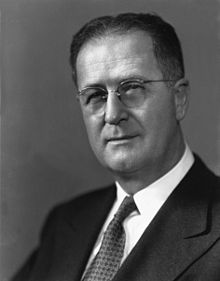Clinton P. Anderson
| Clinton Presba Anderson | |
|---|---|
 |
|
|
United States Senator from New Mexico |
|
|
In office January 3, 1949 – January 3, 1973 |
|
| Preceded by | Carl Hatch |
| Succeeded by | Pete Domenici |
| 13th United States Secretary of Agriculture | |
|
In office June 30, 1945 – May 10, 1948 |
|
| President | Harry S. Truman |
| Preceded by | Claude R. Wickard |
| Succeeded by | Charles F. Brannan |
| Member of the U.S. House of Representatives from New Mexico's At-large district |
|
|
In office January 3, 1941 – June 30, 1945 |
|
| Preceded by | John J. Dempsey |
| Succeeded by | George L. Lusk |
| 9th New Mexico State Treasurer | |
|
In office January 7, 1933 – 1934 |
|
| Preceded by | Warren R. Graham, Sr. |
| Succeeded by | James J. Connelly |
| Personal details | |
| Born |
October 23, 1895 Centerville, South Dakota, U.S. |
| Died | November 11, 1975 (aged 80) Albuquerque, New Mexico, U.S. |
| Resting place | Fairview Memorial Park in Albuquerque, New Mexico, U.S. |
| Political party | Democratic Party |
| Spouse(s) | Henrietta McCartney Anderson (1899 - 1994) |
| Children | Sherburne Presba Anderson Nancy Anderson |
| Parents | Andrew Jay Anderson Hattie Belle Presba Anderson |
| Residence | Albuquerque, New Mexico |
| Profession | Politician |
| Religion | Presbyterian |
Clinton Presba Anderson (October 23, 1895 – November 11, 1975) was an American politician. A member of the Democratic Party, he served as a U.S. Representative from New Mexico from 1941 until 1945, the U.S. Secretary of Agriculture from 1945 until 1948, and a U.S. Senator from New Mexico from 1949 to 1973.
Anderson was born in Centerville, South Dakota, on October 23, 1895. His parents were Andrew Jay and Hattie Belle Anderson (née Presba). He was educated in the public school system of South Dakota, attended Dakota Wesleyan University (1913-1915) and the University of Michigan (1915-1916), though he never received a degree from either institution.
After his father broke his back in 1916, Anderson left the University of Michigan to go home to help support his family. He worked for several months for a newspaper in Mitchell, South Dakota, until he became seriously ill with tuberculosis. He was not aware of his illness until he attempted to join the military in 1917 upon America's entrance into World War I. Doctors gave him six months to live. One gave him the advice to check himself into the Methodist Sanitarium in Albuquerque, New Mexico. He promptly did so, and while recovering there, occasionally wrote for the Herald of the Wells County.
In 1919, as soon as he was well enough to leave the sanitarium, he gained employment with the Albuquerque Journal, then called the Albuquerque Morning Journal and was sent to Santa Fe, New Mexico to cover the state's legislature. Very critical of how the Republican Party was running the state, he befriended some New Mexico Democratic legislators and gave them his ideas on bills before the legislature. Some of those ideas eventually became state law and Anderson began a lifelong association with the Democratic Party.
...
Wikipedia
